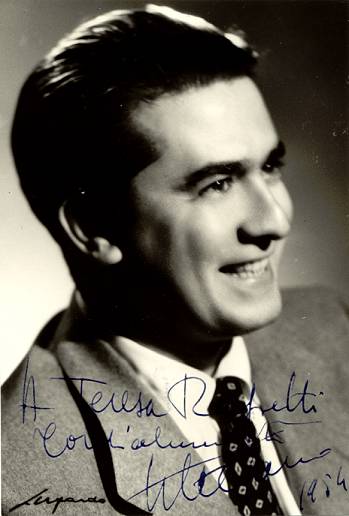Giuseppe Di Stefano (Giuseppe Di Stefano)

Giuseppe Di Stefano was born in Motta Sant’Anastasia, a village near Catania, Sicily, in 1921. He was the only son of a carabiniere turned cobbler and his dressmaker wife. Di Stefano was educated at a Jesuit seminary and briefly contemplated entering the priesthood. After serving in the Italian military (and briefly taking lessons from the Swiss tenor Hugues Cuénod), Di Stefano made his operatic debut in 1946 in Reggio Emilia as Des Grieux in Massenet’s Manon, the role in which he made his La Scala debut the following year. He made his New York debut at the Metropolitan Opera in February 1948 as the Duke of Mantua in Verdi’s Rigoletto after singing the role in Riccione with Hjördis Schymberg in August of the previous year. After his performance in Manon a month later, Musical America wrote that Giuseppe Di Stefano “had the rich velvety sound we have seldom heard since the days of Gigli”. He went on to perform regularly in New York for many years. In 1957, Di Stefano made his British debut at the Edinburgh Festival as Nemorino in L’elisir d’amore and his Royal Opera House, Covent Garden, debut in 1961, as Cavaradossi in Tosca. As a singer, Di Stefano was admired for his excellent diction, unique timbre, passionate delivery and, in particular, for the sweetness of his soft singing. In his Metropolitan Opera radio broadcast debut in Faust, he attacked the high C forte and then softened to a pianissimo. Sir Rudolf Bing said in his memoirs, “The most spectacular single moment in my observation year had come when I heard his diminuendo on the high C in “Salut! demeure” in Faust: I shall never as long as I live forget the beauty of that sound”. During his years of international celebrity, Di Stefano won a gold Orfeo, an Italian musical award.
In 1953 Walter Legge, leader of EMI’s classical wing, wanted a tenor to record all the popular Italian operas with Maria Callas, and chose Giuseppe Di Stefano. Among their recording achievements was the famous 1953 studio recording of Tosca under Victor de Sabata, which is considered “as being one of the great performances in the history of the gramophone”. The two also performed together on stage frequently, from 1951 in South America to the end of 1957 in Un ballo in maschera at La Scala, the last time the two collaborated in an opera. He sang Alfredo to Callas in the famous Visconti production of La traviata in 1955 at La Scala, as well as Edgardo to her Lucia under Herbert von Karajan at La Scala, Berlin and Vienna. In 1973, Di Stefano accompanied Maria Callas on her final recital tour that ended in 1974: critics remarked that both were losing their voices, but the public reaction was enthusiastic everywhere. It was during this period the two had a brief romantic relationship. Di Stefano’s final operatic role was as the aged Emperor in Turandot, in July 1992. In November 2004, Di Stefano was critically injured in his home in Diani Beach, Kenya, after a brutal beating by unknown assailants. He was ambushed in his car with his wife, Monika Curth, as they prepared to drive from their villa in Diani, a coastal resort near Mombasa on the Indian Ocean. The singer was still unconscious a week after the attack and was fed intravenously, and underwent several operations. After two surgeries in Mombasa, Di Stefano was flown to the San Raffaele clinic at Milan in December 2004, where he slipped into a coma. Eventually he awakened from coma, but his health never fully improved. Giuseppe Di Stefano died in his home in Santa Maria Hoè, north of Milan, on 3 March 2008 at the age of 86. Luciano Pavarotti said he modeled himself after Di Stefano, a fact that gained much attention after Pavarotti’s death in September 2007. He was also the tenor who most inspired José Carreras.
Born
- July, 24, 1921
- Motta Sant'Anastasia, Italy
Died
- March, 03, 2008
- Santa Maria Hoè, Italy
Cemetery
- Church of Santa Maria Hoe
- Lombardia, Italy



